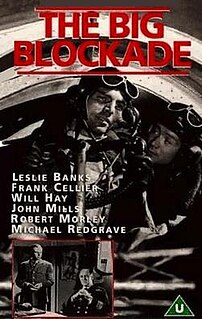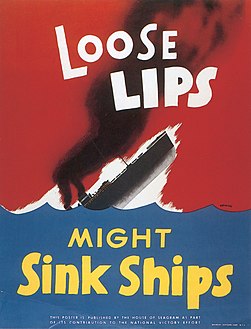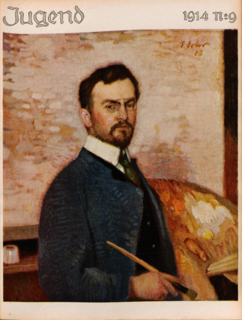| Reginald Mount | |
|---|---|
A wartime poster by Mount, showing a Hawker Hurricane aircraft, one of a series of posters intended to be sent to the Soviet Union | |
| Born | Edward Reginald Mount 4 July 1906 |
| Died | 31 January 1979 (aged 72) |
| Occupation | Graphic designer |
| Organization | Ministry of Information (United Kingdom) |
Reginald Mount (1906–1979 [1] ) was a British graphic designer.

Graphic design is the process of visual communication and problem-solving through the use of typography, photography and illustration. The field is considered a subset of visual communication and communication design, but sometimes the term "graphic design" is used synonymously. Graphic designers create and combine symbols, images and text to form visual representations of ideas and messages. They use typography, visual arts and page layout techniques to create visual compositions. Common uses of graphic design include corporate design, editorial design, wayfinding or environmental design, advertising, web design, communication design, product packaging and signage.
Mount was born Edward Reginald Mount, [2] on 4 July 1906. He worked as a designer for various advertising agencies in London in the 1930s, then joined the Ministry of Information at the outbreak of the Second World War. [1]

The Ministry of Information (MOI), headed by the Minister of Information, was a United Kingdom government department created briefly at the end of the First World War and again during the Second World War. Located in Senate House at the University of London during the 1940s, it was the central government department responsible for publicity and propaganda.

World War II, also known as the Second World War, was a global war that lasted from 1939 to 1945. The vast majority of the world's countries—including all the great powers—eventually formed two opposing military alliances: the Allies and the Axis. A state of total war emerged, directly involving more than 100 million people from over 30 countries. The major participants threw their entire economic, industrial, and scientific capabilities behind the war effort, blurring the distinction between civilian and military resources. World War II was the deadliest conflict in human history, marked by 50 to 85 million fatalities, most of whom were civilians in the Soviet Union and China. It included massacres, the genocide of the Holocaust, strategic bombing, premeditated death from starvation and disease, and the only use of nuclear weapons in war.
Throughout the war, Mount worked extensively with the designer Eileen Evans. Together, they produced many posters for the Ministry's public awareness and propaganda campaigns, including their renowned anti-venereal disease campaign of 1943–1944. [1] Other designer colleagues in the Ministry of Information's "general division" included Maurice V. Bennett and Kenneth Bird, better known as the cartoonist 'Fougasse'. Their work was overseen by the Ministry's studio manager, Edwin Embleton. [3]
Eileen Margaret Evans is a British graphic designer who co-founded the Mount/Evans design studio with graphic designer, Reginald Mount after World War II.
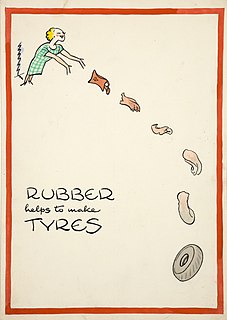
Cyril Kenneth Bird CBE, known by the pen name Fougasse, was a British cartoonist best known for his work in Punch magazine and his World War II warning propaganda posters. He also designed many posters for the London Underground.
Edwin Embleton was a commercial and graphic designer who is widely recognised for his work in the Publications Division of the Ministry of Information during the Second World War.
Some time after 1941, he worked on a series of posters probably intended for export to the Soviet Union (they were accompanied by Russian text). The example pictured shows a hand, representing the merchant navy carrying a Hawker Hurricane to the USSR, to reinforce the Soviet air force. [4] Several of his wartime works depict an anthropomorphised, cartoon-style incendiary bomb, 'Fire-bomb Fritz'. [5] [6] [7]

The Soviet Union, officially the Union of Soviet Socialist Republics (USSR), was a socialist state in Eurasia that existed from 1922 to 1991. Nominally a union of multiple national Soviet republics, its government and economy were highly centralized. The country was a one-party state, governed by the Communist Party with Moscow as its capital in its largest republic, the Russian Soviet Federative Socialist Republic. Other major urban centres were Leningrad, Kiev, Minsk, Alma-Ata, and Novosibirsk. It spanned over 10,000 kilometres east to west across 11 time zones, and over 7,200 kilometres north to south. It had five climate zones: tundra, taiga, steppes, desert and mountains.

A merchant navy or merchant marine or mercantile marine is the fleet of merchant vessels that are registered in a specific country. On merchant vessels, seafarers of various ranks and sometimes members of maritime trade unions are required by the International Convention on Standards of Training, Certification and Watchkeeping for Seafarers (STCW) to carry Merchant Mariner's Documents.

The Hawker Hurricane is a British single-seat fighter aircraft of the 1930s–40s that was designed and predominantly built by Hawker Aircraft Ltd. for service with the Royal Air Force (RAF). It was overshadowed in the public consciousness by the Supermarine Spitfire's role during Battle of Britain in 1940, but the Hurricane actually inflicted 60 percent of the losses sustained by the Luftwaffe in the engagement, and it went on to fight in all the major theatres of the Second World War.
Mount was subsequently a founding member of the Artist Partners agency, which was established in 1950 by the agent Donovan Candler in Lower John Street, Soho, London. [8]

Soho is an area of the City of Westminster, part of the West End of London. Originally a fashionable district for the aristocracy, it has been one of the main entertainment districts in the capital since the 19th century.
Mount continued to work in partnership with Eileen Evans. In the 1950s and 1960s, their 'Mount/Evans studio' became closely associated with the post-war Central Office of Information, producing designs for a wide variety of government agencies. Mount also designed the cinema poster for the British comedy film The Ladykillers . [1]

The Central Office of Information (COI) was the UK government's marketing and communications agency. Its Chief Executive reported to the Minister for the Cabinet Office. It was a non-ministerial department, and became an executive agency and a trading fund, recovering its costs from the other departments, executive agencies and publicly funded bodies which used its services.
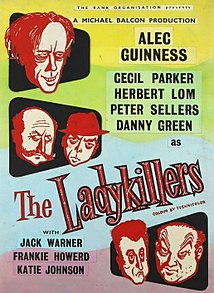
The Ladykillers is a 1955 British black comedy crime film directed by Alexander Mackendrick for Ealing Studios. It stars Alec Guinness, Cecil Parker, Herbert Lom, Peter Sellers, Danny Green, Jack Warner and Katie Johnson as the old lady; Mrs. Wilberforce. William Rose wrote the screenplay, for which he was nominated for an Academy Award for Best Original Screenplay and won the BAFTA Award for Best British Screenplay. He claimed to have dreamt the entire film and merely had to remember the details when he awoke.
His work is in collections including those of The National Archives, [1] The Science Museum, [9] and the Victoria and Albert Museum. [2]
Mount died on 31 January 1979.


